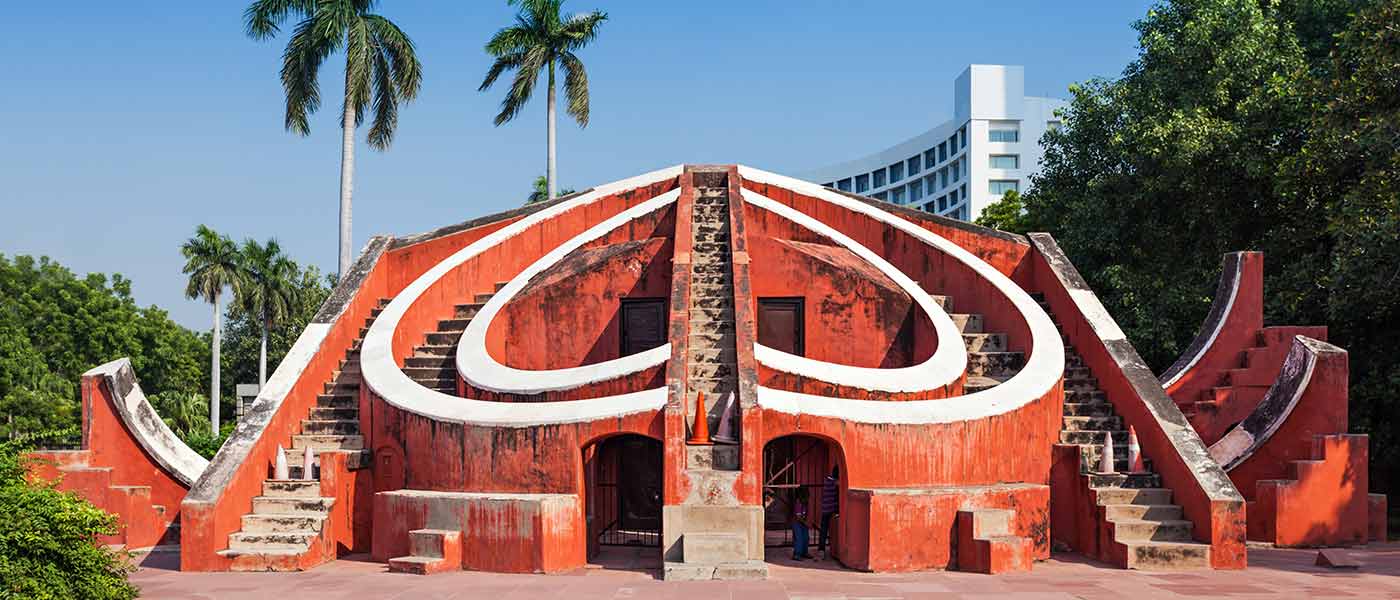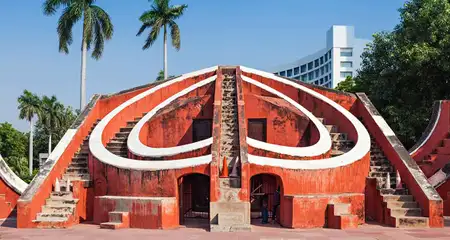Located in the heart of Delhi, Jantar Mantar is an astronomical observatory and equinoctial sundial that dates back to the 18th century. A visit to this place will help you explore old-word astronomy and understand how people of bygone eras determined the time and discovered the location and movements of celestial bodies. When planning to book your hotel in Delhi for a holiday trip, make sure to include this heritage attraction in your itinerary.
Are you curious to know more about this nearly 300-year-old structure? This blog tells you everything you should know about the Jantar Mantar in Delhi, including the history, timings, entry fee, and other interesting details.
Jantar Mantar New Delhi, Information:
| Location | Connaught Place |
| Timings | 6:00 am to 6:00 pm |
| Entry Fee | ₹ 15 for Indians; ₹ 200 for foreigners |
| Still Camera | Free |
| Video Camera | ₹ 25 |
| Nearest Metro Station | Patel Chowk |
| Type | Astronomical Observatory |
| Year of Establishment | 1724 |
| Founded by | Maharaja Jai Singh II |
| Key Attractions | 13 Astronomical Instruments |
Jantar Mantar: History
Jantar Mantar, Delhi was built by Maharaja Jai Singh II of Jaipur in the year 1724. In fact, the king had established five observatories during his reign in the early 18th century and the one in Delhi was the first to be built among these five. The other four observatories are located in Jaipur, Varanasi, Ujjain, and Mathura.
The main objective of building the observatory was to assemble astronomical tables and to accurately predict the movements of the planets, moon, and sun. At that time, it was a one-of-its-kind observatory to be built in India. But by 1867, Jantar Mantar in Delhi underwent considerable decay. Much later, the Government of India took several initiatives to restore the heritage observatory and promote it as a tourist destination in Delhi.
Jantar Mantar Architecture
The huge observatory contains a number of astronomical structures and instruments, all of which are built entirely of masonry. These instruments were built using brick, limestone, and rubble, and finally plastered. Another unique feature of Jantar Mantar, Delhi is that it is an outdoor observatory. All the instruments here are installed in the open rather than being enclosed within buildings or rooms.
Though the structures and instruments have stood the test of time, they did need a bit of repairing and restoring over the years. But as of date, no significant alterations have been made to these structures inside the Jantar Mantar in Delhi.
Structures inside the Jantar Mantar Complex
The Jantar Mantar observatory in Delhi comprises of 13 astronomical instruments of which four are primary devices. These are Samrat Yantra, the Jayaprakash Yantra, the Rama Yantra, and the Misra Yantra. Most of these instruments were designed by Maharaja Jai Singh II. Here’s a description of each:
- Samrat Yantra
Also known as the Supreme Instrument, it stands as the main structure inside the observatory. This structure is 70 feet in height, 114 feet in length at the base, and 10 feet thick. It is a giant triangle-shaped sundial with a hypotenuse that is 128 feet in length. This hypotenuse is placed parallel to the axis of the Earth and is pointed towards the North Pole. On either side of the triangle, a quadrant exists which has graduations that indicate the seconds, minutes, and hours.
- Jayaprakash Yantra
This instrument comprises of structures mimicking hollow hemispheres that are marked on their concave surfaces. Jayaprakash Yantra was used to align the position of the Sun and the stars in the sky.
- Rama Yantra
This instrument has two large structures of cylindrical shapes and open tops. These structures help to determine the altitude of the stars based on the longitude and latitude of the Earth.
- Misra Yantra
It consists of five different instruments which are used to find out the longest and the shortest days of the year. These instruments are known as the Dakshinottara Bhitti, Samrat, Niyat Chakra, Karka Rasivalaya, and the Western Quadrant. The Misra Yantra is also effective for determining the exact noon time. It is believed to be the only instrument in the Jantar Mantar that was not invented by Maharaja Jai Singh II.
Jantar Mantar: Today
Though the country has many modern observatories today, the significance of this heritage structure hasn’t diminished. Needless to say, Jantar Mantar remains one of the top places to visit in Delhi, especially for history buffs, students, and science enthusiasts. The observatory may no longer be used to calculate the position of the heavenly bodies or to determine the time. However, it remains an undying testimony to man’s persistence and interest to unravel the mysteries of the universe.
Lesser Known Facts about Jantar Mantar
- When this observatory was built, sundials were already in use. But the Samrat Yantra inside this observatory modified the basic sundial into a precise instrument for determining various factors about the heavenly bodies, including the declination angle of the planets.
- During the 1982 Asian Games held in New Delhi, Jantar Mantar was used on the logo of the event.
- The instruments inside the observatory are constructed and placed intelligently that observers could note the positions of celestial bodies with naked eyes.
- The observatory was operational for almost 7 years during which data was collated, calculated, and handed over to the ruling king. However, when tall buildings were constructed around the structure, it stopped giving accurate data.
- The name Jantar Mantar is derived from two words jantra or yantra meaning instrument and mantra, which means calculate. So when putting together, these words mean ‘calculation instrument’.
Attractions near Jantar Mantar, Delhi
- Bangla Sahib Gurudwara (700 m)
- National Museum (2.3 km)
- Birla Temple (2.6 km)
- Parliament House (2.7 km)
- Rashtrapati Bhavan (2.8 km)
- Agrasen ki Baoli (3.6 km)
- Gandhi Smriti (4.1 km)
- Khooni Darwaza (4.4 km)
- Delhi Zoo (5 km)
- Humayun’s Tomb (6.6 km)
Won’t it be really exciting to visit this age-old observatory that had once helped even the kings and emperors to learn about the stars and planets in the sky? The structure testifies to the fact that India had made big leaps in the realm of science even centuries ago. And while you are in the capital city, make sure to visit the other historical places in Delhi that narrate its rich history and heritage.




























